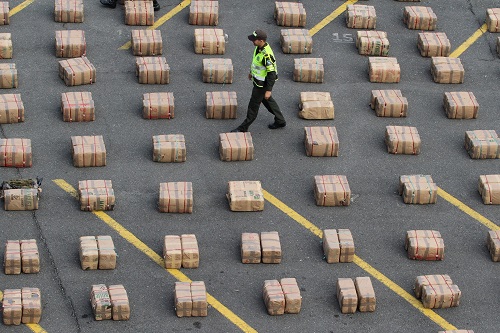AFP photo
By
Ricardo Swire
Brazil, Colombia and Venezuela were identified in the 2016 European Union Drug Trafficking Report as “key departure points” in Europe’s cocaine trade.
Nationally, economic libretto of “reverse fortunes” plays out between Venezuela and Colombia. The country’s 1990 bloody narco-wars featured Pablo Escobar or “The King of Cocaine,” the wealthiest criminal in history, with a net worth of US$30 billion. Associated crime and violence encouraged several Colombians to migrate to prosperous Venezuela, home of the world’s largest oil reserves.
Presently oil’s international market price is below US$3 per gallon and for the first time, in one hundred years of production, Venezuela is importing crude. The country’s two hundred and fifty-six billion barrels of extra-heavy oil is composed of several minerals, sulfur and the viscosity of molasses costly to refine. Commercially Venezuela’s natural resource commodity is diluted with lighter blends or synthetics, a tactic in use by state oil company Petroleos de Venezuela SA (PDVSA) to compensate for lack of cash to pay for oil upgraders.
Today Venezuelans flee to Colombia for sanctuary from hardships in a country financially broke, without adequate food and medical supplies. The International Monetary Fund (IMF) calculated 2017 as Venezuela’s fourth year battling recession, with no economic growth since 2013. The 2016 European Monitoring Centre for Drugs & Drug Addiction (EMCDDA) in collaboration with EUROPOL’s joint Report contradicted segments of the United Nations Office on Drugs & Crime (UNODC) data.
EMCDDA/EUROPOL statistics showed Central America and the Caribbean registered increased cocaine seizures. 2013’s one hundred and sixty-two metric tons of confiscated product doubled 2012’s seventy-eight metric tons. Colombian cocaine shipments, smuggled across the “porous border” to Venezuela, also increased. Traffickers maximized the disguise provided by heavy traffic of commercial and pleasure craft that navigate Venezuela’s coast.
Venezuelan criminal syndicates utilize both air and sea routes across the Atlantic Ocean, for product journeying to southern Europe. Patterns depicted traffickers prefer Caribbean transit facilities instead of Central America for consignments directed exclusively to this market. Some navigate via Eastern Caribbean islands. The Dominican Republic (DR) and Jamaica named main trafficking lanes. Brazil’s elevated status indicated Bolivia and Peru have matured as Europe’s cocaine market suppliers.
EMCDDA/EUROPOL analysts also found in 2015 the DR recorded seizures equal to an eight hundred percent growth, or eighty-six metric tons of cocaine. This escalation of drugs transportation through Caribbean waters resulted from ongoing pressure applied by Mexico/Central America counter-narcotics offensives. The large capacity and diversity of routes, offered by sundry maritime transport types, qualify sea routes as preferred option for cocaine movement to Europe. Since 2006 seizures of cocaine, hidden inside shipping containers, increased six fold.
West Africa’s Bight of Benin between Ghana and Nigeria plus Cape Verdi Islands, Madeira and the Canary Islands, comprise the second most important transit zone for cocaine consignments moving to Europe. The EMCDDA/EUROPOL expressed concern about adoption of existing trafficking routes, used to transport other contraband including cannabis corridors in Morocco and Algeria plus heroin corridors in Tanzania, now facilitate cocaine. Based on East Africa’s increased seizures and the Panama Canal’s expansion, Tanzania adds to European cocaine routes.
Rotterdam port in Holland and Antwerp port in Belgium identified as key cocaine entry points. Eleven million shipping containers transit Rotterdam port yearly, only fifty thousand or forty-five percent are scanned. Dutch National Police Corps approximated twenty-five to fifty percent of arriving cocaine shipments are channeled to Europe via Rotterdam. In 2013 counter-narcotics officers intercepted ten metric tons at the Holland port. Algeciras and Valencia in Spain and Hamburg port in Germany are the other main cocaine entry ports. In 2014 Belgium, France, Italy, the Netherlands and Spain accounted for eighty percent of sixty-one point six metric tons of cocaine seized in the EU.
Ricardo Swire
Ricardo Swire is the Principal Consultant at R-L-H Security Consultants & Business Support Services and writes on a number of important issues.



No Comments Yet!
You can be first to comment this post!